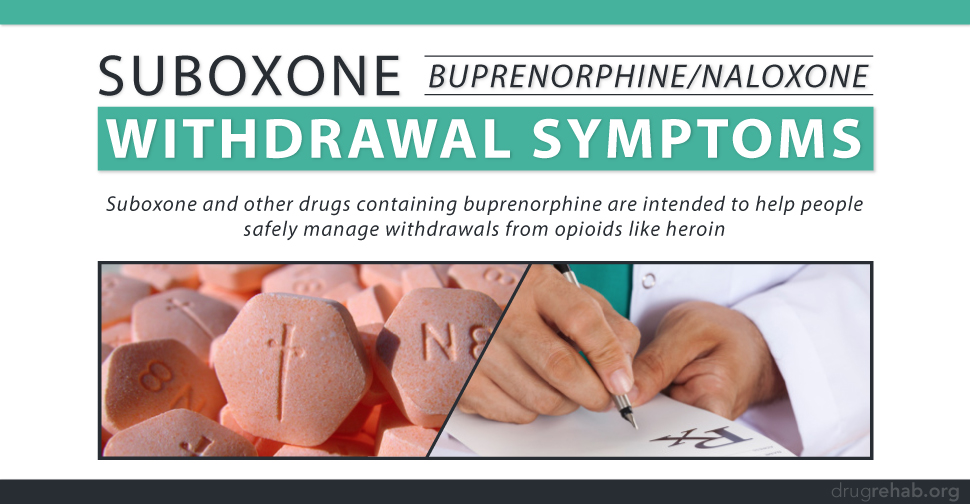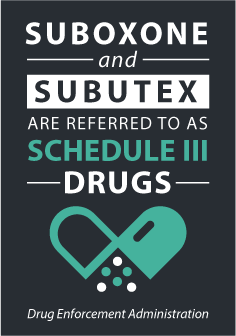
Suboxone and other drugs containing buprenorphine (Subutex, Zubsolv, etc) are intended to help people safely manage withdrawals from opioids like heroin. Outside of a clinical setting Suboxone may be used as a form of Medication-Assisted Treatment (MAT). Unfortunately, Suboxone may be misused and/or abused. Additionally, combining Suboxone with alcohol or other medications such as benzodiazepines may lead to overdose or death. It is crucial that individuals looking to get off of Suboxone to do so under medical supervision to minimize withdrawal symptoms and risk of relapse.
Have you ever gone on a vacation that you never wanted to end? Maybe when it finally ended, you didn’t feel like you could ever be happy again. Drug withdrawals kind of work in the same way. Your brain becomes dependent on the euphoria (happiness) that a drug provides, and then once it’s gone, your brain almost through a state of depression. Even medications, that are meant to help manage withdrawals, like Suboxone can have withdrawals of their own. Though typically professionals will wean patients off of prescription drugs like Suboxone so that the withdrawals are minimal.
What Is Suboxone?
Suboxone is an partial agonist used to make opiate withdrawals a little more bearable. It’s made up of a 4 to 1 ratio of buprenorphine and naloxone and by the Food And Drug Administration’s standard, “Suboxone is the preferred medication for maintenance treatment due to the presence of naloxone in the formulation, which is intended to deter intravenous abuse by persons dependent on other opiates.” Suboxone and Subutex (which doesn’t contain any naloxone) can keep a person from abusing opioid drugs like heroin, morphine, hydrocodone, or oxycodone, but at the same time they too are drugs.

What Are The Advantages Of Buprenorphine?
Other than the obvious reasoning of no longer dealing with an opiate addiction, buprenorphine drugs like Suboxone can have some other lesser known advantages. “The main advantages of buprenorphine are:
- You are unlikely to overdose on buprenorphine if you take it properly.
- Buprenorphine is long acting. This means that after an initial period, your doctor may have you take the pill every other day rather than once a day.
- Doctors can prescribe buprenorphine so that you can take doses at home. Important: Not all doctors have approval to prescribe this medication, and not all doctors provide counseling for addiction. Also, daily check-in at a treatment center can be helpful to recovery. Therefore, for some people, a treatment center is the best place to receive medication for opioid addiction.”
(Substance Abuse and Mental Health Services Administration)
More About Buprenorphine Drugs
Suboxone and Subutex are referred to as schedule III drugs by the Drug Enforcement Administration (DEA). Even though buprenorphine is considered to be “20-30 times more potent than morphine as an analgesic; and like morphine it produces dose-related euphoria,” it “…produces less respiratory depression at high doses than other narcotic treatment drugs” (DEA).
Some of the other medications used to treat an opiate addiction are Methadone and Naltrexone. In more ways than one, partial agonists like Suboxone are safer than heroin and drugs of the sort, however when a person decides to stop using them (as with many medications) they will most likely experience some withdrawals.
Definition Of Withdrawal
 Withdrawals are symptoms that usually occur after a person becomes dependent on a substance and then goes without it. They can happen with any drug, and the longer a person uses a drug, the more of that drug they will need to achieve the same high. Needing more of a drug over time is known as building up a tolerance…
Withdrawals are symptoms that usually occur after a person becomes dependent on a substance and then goes without it. They can happen with any drug, and the longer a person uses a drug, the more of that drug they will need to achieve the same high. Needing more of a drug over time is known as building up a tolerance…
Withdrawal can be easier to understand with a definition by the U.S. National Library of Medicine, “(opioids) can cause physical dependence. This means that a person relies on the drug to prevent withdrawal symptoms. Over time, more of the drug is needed for the same effect…
How long it takes to become physically dependent varies with each person. When the person stops taking the drugs, the body needs time to recover. This causes withdrawal symptoms. Withdrawal from opiates can occur any time long-term use is stopped or cut back.”
Most Common Withdrawal Symptoms And Side Effects Of Suboxone
Just like the amount of time that it takes each person to become dependent on a drug varies, so do the withdrawal symptoms that each person will experience. In other words not everyone will become addicted to opioids, and thus not every person will experience withdrawals. Those who become addicted might have:
- Craving—The mind develops an overwhelming desire for the drug.
- Loss of Control—It becomes harder to say no to using the drug. Use is compulsive and continues even though the drug causes harm.
Some of the side effects and withdrawal symptoms that can occur when a person stops using Suboxone are:
- Body aches, headaches, and cold or flu-like symptoms—Check with your doctor about over-the-counter medicines you may take.
- Dizziness—Stand up slowly. Call your doctor if problems persist.
- Constipation—Drink more water and juice. Eat food with fiber. Exercise more.
- Sweating—Shower often. Dress in layers.
- Sleep problems, including tiredness—Take the pill in the morning. Avoid naps. Go to bed at the same time every night. Exercise. Do not drink caffeine after lunchtime.
- Upset stomach or vomiting—Take the pill after you have eaten. Take an antacid product as directed by your doctor.
- Mood swings—Exercise more. Do fun things that do not involve the old drug lifestyle. Relax. Talk to your substance abuse treatment provider.
- Serious side effects—For extreme stomach pain, vomiting, or diarrhea, contact your doctor right away.
Also seek help if the following side effects appear, because they may indicate serious liver problems:
- Dark or tea-colored urine
- Bad stomachache
- Light-colored bowel movements
- Yellowing in the whites of the eyes
- Yellow skin
(Substance Abuse and Mental Health Services Administration – SAMHSA)
How Long Do Suboxone Withdrawals Last?
Like many other drugs, the duration of physical withdrawal symptoms depends on how much of, and for how long a person was taking the drug. The withdrawal symptoms from Suboxone and other drugs containing buprenorphine usually last a month or so.
Can I Die From Suboxone?
A person will not die from Suboxone if the drug is taken properly—“however, severe respiratory depression can occur when buprenorphine is combined with other central nervous system depressants, especially benzodiazepines. Deaths have resulted from this combination” (DEA).
Medication-Assisted Treatment
Medication-assisted treatment (or medication-assisted therapy) can be used for a lot of different addictions, ranging from alcohol to opioids, and more. What exactly is medication-assisted treatment? “Medication-assisted treatment is treatment for addiction that includes the use of medication along with counseling and other support” (SAMHSA).
A Little Bit About Opiates
The point here is not to scare people away from medication-assisted therapy, it’s to spread awareness about drug abuse and addiction. Even though partial opiate drugs like Suboxone, Subutex, and Zubsolv are meant to help people get off opiates, sometimes they are still abused for their euphoric effects. On the other hand, buprenorphine maintenance has helped a lot of people recover from an opiate addiction; the bottom line is that dosage absolutely must be monitored by a professional.

According to the Substance Abuse and Mental Health Services Administration, “opioids are drugs that slow down the actions of the body, such as breathing and heartbeat. Opioids also affect the brain to increase pleasant feelings. They get their name from opium, a drug made from the poppy plant.”
They go on to say that, “opioid addiction is a chronic disease, like heart disease or diabetes. A chronic disease is a medical condition for life. It cannot be cured, but it can be managed. A person with addiction can regain a healthy, productive life.”
How Many People Are Addicted To Opiates?
There were an estimated “2.1 million people in the United States suffering from substance use disorders related to prescription opioid pain relievers in 2012 and… 467,000 addicted to heroin. The number of unintentional overdose deaths from prescription pain relievers has soared in the United States, more than quadrupling since 1999 ” (National Institute on Drug Abuse). These can be pretty scary statistics to swallow, especially if you’re one of those people.
How To Get Help With An Addiction
If you’re concerned about the withdrawal symptoms of Suboxone or other drugs—or think that a loved one might be abusing them, we can help. There are millions of people who abuse prescription opioids, and tens of thousands of people who die annually. It’s time to make a change. Contact us today, to speak to one of our addiction specialists about how to safely use prescription drugs like Suboxone. If done properly, medication-assisted therapy is a much safer alternative than living with an addiction.
For More Information Related to “Suboxone (Buprenorphine/Naloxone) Withdrawal Symptoms” Be Sure To Check Out These Additional Resources From DrugRehab.org:
- Methadone vs. Suboxone: Pros And Cons Of Both
- What Is The Difference Between Suboxone And Subutex
- How Long Should I Stay On Suboxone?
- How Can Subutex Be Abused?
- Drug Diversion in Hospitals by Professionals
- The Benefits of Faith-Based Recovery Programs
- What Helps With Benzodiazepine Withdrawal?
- How Much Does a Drug and/or Alcohol Intervention Cost?
Sources
Drug Enforcement Administration – Drug & Chemical Evaluation Section: Buprenorphine
U.S. National Library of Medicine – Opiate and Opioid Withdrawal

